高中英语听力教案
- 格式:docx
- 大小:37.21 KB
- 文档页数:3
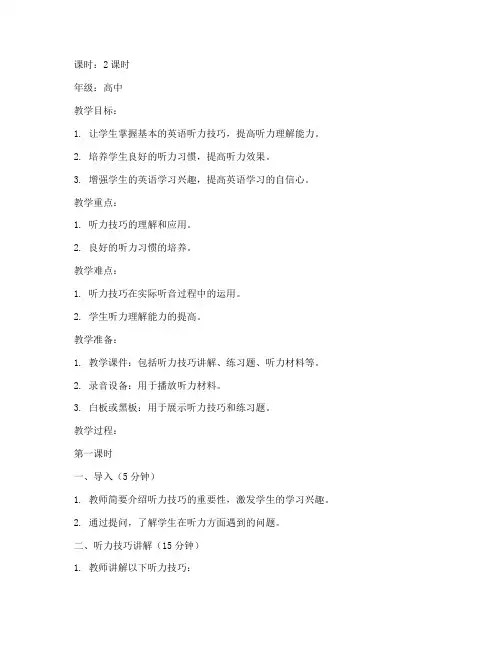
课时:2课时年级:高中教学目标:1. 让学生掌握基本的英语听力技巧,提高听力理解能力。
2. 培养学生良好的听力习惯,提高听力效果。
3. 增强学生的英语学习兴趣,提高英语学习的自信心。
教学重点:1. 听力技巧的理解和应用。
2. 良好的听力习惯的培养。
教学难点:1. 听力技巧在实际听音过程中的运用。
2. 学生听力理解能力的提高。
教学准备:1. 教学课件:包括听力技巧讲解、练习题、听力材料等。
2. 录音设备:用于播放听力材料。
3. 白板或黑板:用于展示听力技巧和练习题。
教学过程:第一课时一、导入(5分钟)1. 教师简要介绍听力技巧的重要性,激发学生的学习兴趣。
2. 通过提问,了解学生在听力方面遇到的问题。
二、听力技巧讲解(15分钟)1. 教师讲解以下听力技巧:a. 学会取舍,理解内容b. 扫视材料,预测内容c. 注重首句,抓住主旨d. 根据已有信息预测答案e. 做好笔记,辅助理解2. 通过实例分析,让学生理解并掌握上述听力技巧。
三、听力技巧练习(20分钟)1. 学生根据所学技巧,完成听力练习题。
2. 教师巡回指导,解答学生疑问。
四、总结与反思(5分钟)1. 教师总结本节课所学内容,强调听力技巧的重要性。
2. 学生分享学习心得,提出改进建议。
第二课时一、复习与巩固(10分钟)1. 学生回顾上一节课所学的听力技巧。
2. 教师提问,检查学生对听力技巧的掌握情况。
二、听力技巧应用(20分钟)1. 教师播放听力材料,学生尝试运用所学技巧进行听力理解。
2. 教师引导学生分析听力材料,总结听力技巧的应用效果。
三、拓展与提高(15分钟)1. 教师提供更高难度的听力材料,让学生进行听力训练。
2. 教师指导学生如何在实际听音过程中运用听力技巧。
四、课堂小结(5分钟)1. 教师总结本节课所学内容,强调听力技巧在实际应用中的重要性。
2. 学生分享学习心得,提出改进建议。
教学评价:1. 课堂表现:学生参与度、课堂纪律等。
2. 听力技巧掌握情况:通过练习题、听力测试等方式评估。
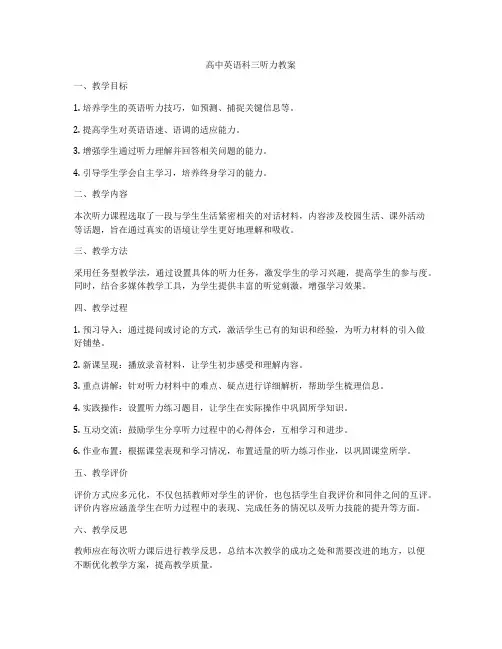
高中英语科三听力教案
一、教学目标
1. 培养学生的英语听力技巧,如预测、捕捉关键信息等。
2. 提高学生对英语语速、语调的适应能力。
3. 增强学生通过听力理解并回答相关问题的能力。
4. 引导学生学会自主学习,培养终身学习的能力。
二、教学内容
本次听力课程选取了一段与学生生活紧密相关的对话材料,内容涉及校园生活、课外活动
等话题,旨在通过真实的语境让学生更好地理解和吸收。
三、教学方法
采用任务型教学法,通过设置具体的听力任务,激发学生的学习兴趣,提高学生的参与度。
同时,结合多媒体教学工具,为学生提供丰富的听觉刺激,增强学习效果。
四、教学过程
1. 预习导入:通过提问或讨论的方式,激活学生已有的知识和经验,为听力材料的引入做
好铺垫。
2. 新课呈现:播放录音材料,让学生初步感受和理解内容。
3. 重点讲解:针对听力材料中的难点、疑点进行详细解析,帮助学生梳理信息。
4. 实践操作:设置听力练习题目,让学生在实际操作中巩固所学知识。
5. 互动交流:鼓励学生分享听力过程中的心得体会,互相学习和进步。
6. 作业布置:根据课堂表现和学习情况,布置适量的听力练习作业,以巩固课堂所学。
五、教学评价
评价方式应多元化,不仅包括教师对学生的评价,也包括学生自我评价和同伴之间的互评。
评价内容应涵盖学生在听力过程中的表现、完成任务的情况以及听力技能的提升等方面。
六、教学反思
教师应在每次听力课后进行教学反思,总结本次教学的成功之处和需要改进的地方,以便
不断优化教学方案,提高教学质量。
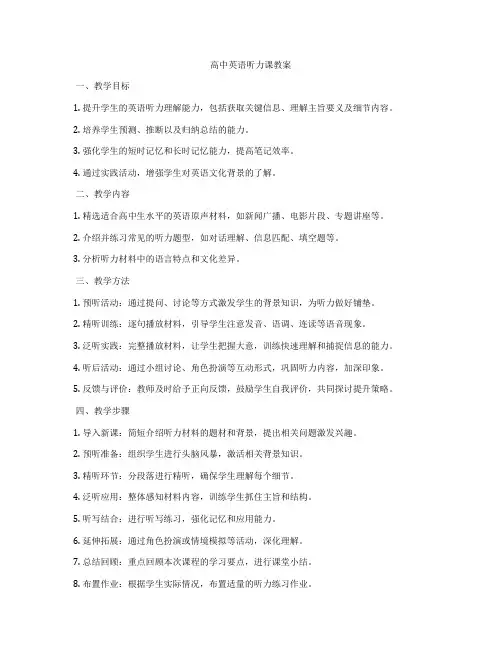
高中英语听力课教案一、教学目标1. 提升学生的英语听力理解能力,包括获取关键信息、理解主旨要义及细节内容。
2. 培养学生预测、推断以及归纳总结的能力。
3. 强化学生的短时记忆和长时记忆能力,提高笔记效率。
4. 通过实践活动,增强学生对英语文化背景的了解。
二、教学内容1. 精选适合高中生水平的英语原声材料,如新闻广播、电影片段、专题讲座等。
2. 介绍并练习常见的听力题型,如对话理解、信息匹配、填空题等。
3. 分析听力材料中的语言特点和文化差异。
三、教学方法1. 预听活动:通过提问、讨论等方式激发学生的背景知识,为听力做好铺垫。
2. 精听训练:逐句播放材料,引导学生注意发音、语调、连读等语音现象。
3. 泛听实践:完整播放材料,让学生把握大意,训练快速理解和捕捉信息的能力。
4. 听后活动:通过小组讨论、角色扮演等互动形式,巩固听力内容,加深印象。
5. 反馈与评价:教师及时给予正向反馈,鼓励学生自我评价,共同探讨提升策略。
四、教学步骤1. 导入新课:简短介绍听力材料的题材和背景,提出相关问题激发兴趣。
2. 预听准备:组织学生进行头脑风暴,激活相关背景知识。
3. 精听环节:分段落进行精听,确保学生理解每个细节。
4. 泛听应用:整体感知材料内容,训练学生抓住主旨和结构。
5. 听写结合:进行听写练习,强化记忆和应用能力。
6. 延伸拓展:通过角色扮演或情境模拟等活动,深化理解。
7. 总结回顾:重点回顾本次课程的学习要点,进行课堂小结。
8. 布置作业:根据学生实际情况,布置适量的听力练习作业。
五、教学资源1. 音频播放器或电脑多媒体设备。
2. 英语听力教材和配套练习册。
3. 互联网资源,如在线听力练习网站、英语学习A等。
六、评价方式1. 平时成绩:包括课堂表现、作业完成情况和平时测验成绩。
2. 期末评估:通过模拟考试或者实际听力测试来综合评估学生的听力水平。
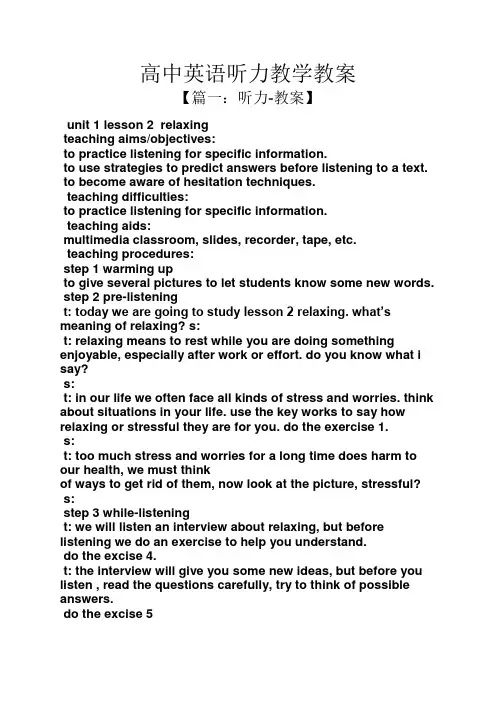
高中英语听力教学教案【篇一:听力-教案】unit 1 lesson 2 relaxingteaching aims/objectives:to practice listening for specific information.to use strategies to predict answers before listening to a text. to become aware of hesitation techniques.teaching difficulties:to practice listening for specific information.teaching aids:multimedia classroom, slides, recorder, tape, etc.teaching procedures:step 1 warming upto give several pictures to let students know some new words. step 2 pre-listeningt: today we are going to study lesson 2 relaxing. what’s meaning of relaxing? s:t: relaxing means to rest while you are doing something enjoyable, especially after work or effort. do you know what i say?s:t: in our life we often face all kinds of stress and worries. think about situations in your life. use the key works to say how relaxing or stressful they are for you. do the exercise 1.s:t: too much stress and worries for a long time does harm to our health, we must thinkof ways to get rid of them, now look at the picture, stressful?s:step 3 while-listeningt: we will listen an interview about relaxing, but before listening we do an exercise to help you understand.do the excise 4.t: the interview will give you some new ideas, but before you listen , read the questions carefully, try to think of possible answers.do the excise 5t: now let me test your remembering ability, you read through the questions, answer them if you can remember any of the answers.students listen to the cassette again and answer the questions. do the exercise 6.t: we will listen to mark’s dialogue about relaxing and stress. i guess maybe you will have the same feeling and experience. pay attention to his stressful actives and relaxing actives to fill the blank.when students have checked their answers, ask them “before exams and before going to parties what do you do to avoid much too stress?do the exercise 7students look at the function file activity and see if they can remember or can guess any of the missing verbs.students listen to the cassette again and complete the sentences in the function file. remind students of these words’ character: v + ing.do the exercise 9in our oral language we often pause. now listen to mark again. which words or sounds does he use to hesitate?students listen to the cassette. after each sentence, pause the tape so that students can repeat the hesitation device.step 4 post-listeningpair-workin pairs students act out a role play in which one person is not sure what to say and so uses a lot of hesitation words. for example, you borrow your friend’s favorite cd last week. now she ask you for it back you can’ t find it.step 5 homeworkdo exercise 2 in the text.design of the blackboard writingunit 1 lifestyleslesson 2 relaxingstress, stressful, pressurestudiodietreflectionsfrom this text, students learn not only the new vocabulary but learn more about the relaxing activities and stressful activities.whats more, learning to use the new knowledge is very important. practice makes perfect. so , much exercise is necessary. this text aims at developing students’ ability to find some specific information,giving homework can help them master the knowledge better.【篇二:高中英语听力说课稿】听力说课稿模板总结教材:本次说课的内容是单元听力部分。
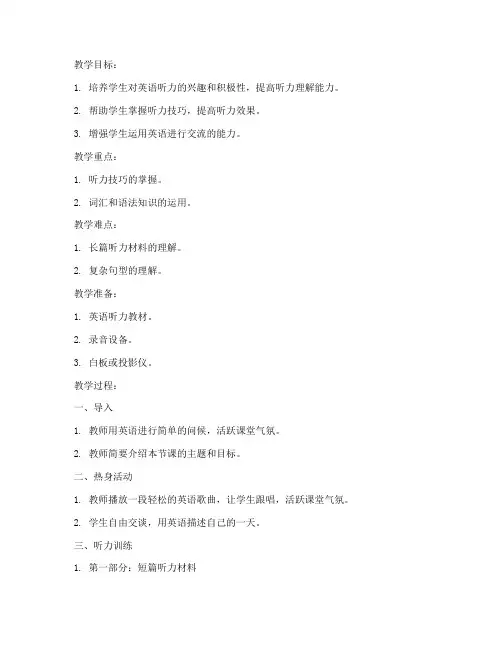
教学目标:1. 培养学生对英语听力的兴趣和积极性,提高听力理解能力。
2. 帮助学生掌握听力技巧,提高听力效果。
3. 增强学生运用英语进行交流的能力。
教学重点:1. 听力技巧的掌握。
2. 词汇和语法知识的运用。
教学难点:1. 长篇听力材料的理解。
2. 复杂句型的理解。
教学准备:1. 英语听力教材。
2. 录音设备。
3. 白板或投影仪。
教学过程:一、导入1. 教师用英语进行简单的问候,活跃课堂气氛。
2. 教师简要介绍本节课的主题和目标。
二、热身活动1. 教师播放一段轻松的英语歌曲,让学生跟唱,活跃课堂气氛。
2. 学生自由交谈,用英语描述自己的一天。
三、听力训练1. 第一部分:短篇听力材料a. 教师播放短篇听力材料,学生听后回答问题。
b. 教师讲解听力材料中的重点词汇和语法知识。
c. 学生复述听力材料,巩固所学知识。
2. 第二部分:长篇听力材料a. 教师播放长篇听力材料,学生听后回答问题。
b. 教师讲解听力材料中的重点词汇和语法知识。
c. 学生分组讨论,总结听力材料的主旨大意。
四、练习巩固1. 教师布置听力练习题,学生独立完成。
2. 教师讲解练习题答案,学生总结解题技巧。
五、课堂小结1. 教师总结本节课所学内容,强调重点和难点。
2. 学生分享自己的学习心得,互相鼓励。
六、作业布置1. 完成课后听力练习题。
2. 预习下一节课的内容。
教学反思:1. 教师在课堂上应关注学生的学习情况,及时调整教学策略。
2. 注重培养学生的听力技巧,提高听力效果。
3. 通过课堂练习和作业,巩固所学知识,提高学生的英语听力水平。
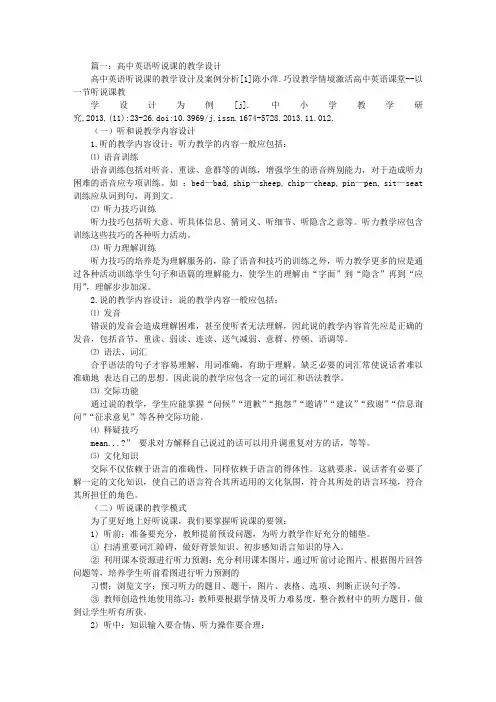
篇一:高中英语听说课的教学设计高中英语听说课的教学设计及案例分析[1]陈小萍.巧设教学情境激活高中英语课堂--以一节听说课教学设计为例[j].中小学教学研究,2013,(11):23-26.doi:10.3969/j.issn.1674-5728.2013.11.012.(一)听和说教学内容设计1.听的教学内容设计:听力教学的内容一般应包括:⑴语音训练语音训练包括对听音、重读、意群等的训练,增强学生的语音辨别能力,对于造成听力困难的语音应专项训练。
如:bed—bad, ship—sheep, chip—cheap, pin—pen, sit—seat 训练应从词到句,再到文。
⑵听力技巧训练听力技巧包括听大意、听具体信息、猜词义、听细节、听隐含之意等。
听力教学应包含训练这些技巧的各种听力活动。
⑶听力理解训练听力技巧的培养是为理解服务的,除了语音和技巧的训练之外,听力教学更多的应是通过各种活动训练学生句子和语篇的理解能力,使学生的理解由“字面”到“隐含”再到“应用”,理解步步加深。
2.说的教学内容设计:说的教学内容一般应包括:⑴发音错误的发音会造成理解困难,甚至使听者无法理解,因此说的教学内容首先应是正确的发音,包括音节、重读、弱读、连读、送气减弱、意群、停顿、语调等。
⑵语法、词汇合乎语法的句子才容易理解,用词准确,有助于理解。
缺乏必要的词汇常使说话者难以准确地表达自己的思想。
因此说的教学应包含一定的词汇和语法教学。
⑶交际功能通过说的教学,学生应能掌握“问候”“道歉”“抱怨”“邀请”“建议”“致谢”“信息询问”“征求意见”等各种交际功能。
⑷释疑技巧mean...?”要求对方解释自己说过的话可以用升调重复对方的话,等等。
⑸文化知识交际不仅依赖于语言的准确性,同样依赖于语言的得体性。
这就要求,说话者有必要了解一定的文化知识,使自己的语言符合其所适用的文化氛围,符合其所处的语言环境,符合其所担任的角色。
(二)听说课的教学模式为了更好地上好听说课,我们要掌握听说课的要领:1) 听前:准备要充分,教师提前预设问题,为听力教学作好充分的铺垫。

5篇2022高中英语听力课教案教案中对每个课题或每个课时的教学内容,教学步骤的安排,教学方法的选择,板书设计,教具或现代化教学手段的应用,各个教学步骤教学环节的时间分配等等,都要经过周密考虑,精心设计而确定下来,体现着很强的计划性。
以下是小编带来的高中英语听力课教案内容,感谢您的阅读,希望能帮助到您!高中英语听力课教案1esson 1 一、自我介绍(Introduce myself 3′) Hello everybody, Well,nice talking with you here. I'm your English teacher, next year we will learn together, with the progress. I have worked for 1 years since I graduated from the university . Being a teacher is tired but excited . Having taught for this year, I think I am experienced in teaching field . I have a strong sense of duty and humor.Actually , I always think that English is so wonderful a language that we should not only regard it as a subject,but also look on it with great interest.Hope you can enjoy your way in English.I will be happy to be your company. 二、学习方法介绍( 20′) -。
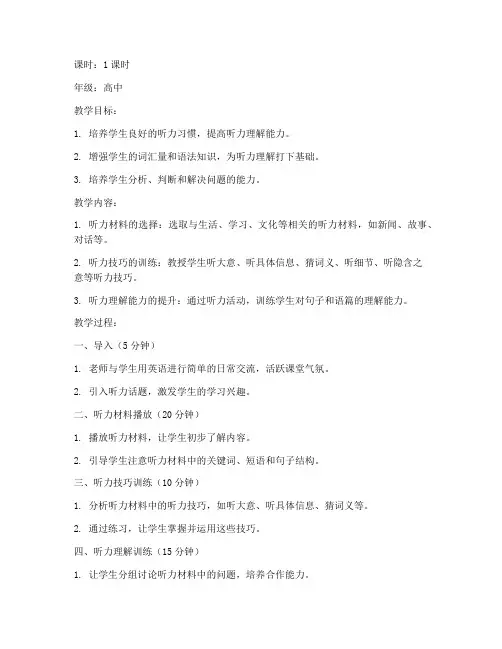
课时:1课时年级:高中教学目标:1. 培养学生良好的听力习惯,提高听力理解能力。
2. 增强学生的词汇量和语法知识,为听力理解打下基础。
3. 培养学生分析、判断和解决问题的能力。
教学内容:1. 听力材料的选择:选取与生活、学习、文化等相关的听力材料,如新闻、故事、对话等。
2. 听力技巧的训练:教授学生听大意、听具体信息、猜词义、听细节、听隐含之意等听力技巧。
3. 听力理解能力的提升:通过听力活动,训练学生对句子和语篇的理解能力。
教学过程:一、导入(5分钟)1. 老师与学生用英语进行简单的日常交流,活跃课堂气氛。
2. 引入听力话题,激发学生的学习兴趣。
二、听力材料播放(20分钟)1. 播放听力材料,让学生初步了解内容。
2. 引导学生注意听力材料中的关键词、短语和句子结构。
三、听力技巧训练(10分钟)1. 分析听力材料中的听力技巧,如听大意、听具体信息、猜词义等。
2. 通过练习,让学生掌握并运用这些技巧。
四、听力理解训练(15分钟)1. 让学生分组讨论听力材料中的问题,培养合作能力。
2. 老师根据学生的讨论情况,进行点评和讲解。
五、总结与反馈(5分钟)1. 老师总结本节课的重点内容,强调听力技巧的重要性。
2. 学生反馈学习心得,分享听力经验。
教学评价:1. 学生在课堂上的参与度,如提问、回答问题等。
2. 学生对听力材料的理解程度,如回答问题的准确性、完整性等。
3. 学生对听力技巧的掌握程度,如运用技巧的熟练度等。
教学资源:1. 多媒体设备,如电脑、音响等。
2. 听力材料,如录音带、光盘等。
3. 教学课件,如PPT等。
教学反思:1. 教师在备课过程中,应充分了解学生的需求,选择合适的听力材料。
2. 在课堂教学中,教师应注重培养学生的听力技巧,提高学生的听力理解能力。
3. 教师应关注学生的学习情况,及时调整教学策略,确保教学效果。
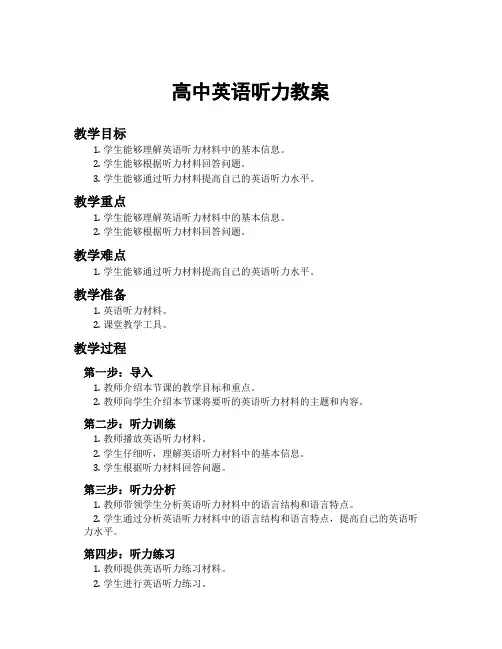
高中英语听力教案教学目标1.学生能够理解英语听力材料中的基本信息。
2.学生能够根据听力材料回答问题。
3.学生能够通过听力材料提高自己的英语听力水平。
教学重点1.学生能够理解英语听力材料中的基本信息。
2.学生能够根据听力材料回答问题。
教学难点1.学生能够通过听力材料提高自己的英语听力水平。
教学准备1.英语听力材料。
2.课堂教学工具。
教学过程第一步:导入1.教师介绍本节课的教学目标和重点。
2.教师向学生介绍本节课将要听的英语听力材料的主题和内容。
第二步:听力训练1.教师播放英语听力材料。
2.学生仔细听,理解英语听力材料中的基本信息。
3.学生根据听力材料回答问题。
第三步:听力分析1.教师带领学生分析英语听力材料中的语言结构和语言特点。
2.学生通过分析英语听力材料中的语言结构和语言特点,提高自己的英语听力水平。
第四步:听力练习1.教师提供英语听力练习材料。
2.学生进行英语听力练习。
第五步:总结1.教师总结本节课的教学内容和学习方法。
2.学生回顾本节课的学习内容和学习方法。
教学反思通过本节课的教学,学生能够理解英语听力材料中的基本信息,能够根据听力材料回答问题,能够通过听力材料提高自己的英语听力水平。
同时,学生也能够通过分析英语听力材料中的语言结构和语言特点,提高自己的英语听力水平。
在教学过程中,教师应该注重听力训练和听力练习,让学生在实践中提高自己的英语听力水平。
同时,教师也应该注重学生的反思和总结,让学生在反思和总结中提高自己的英语听力水平。
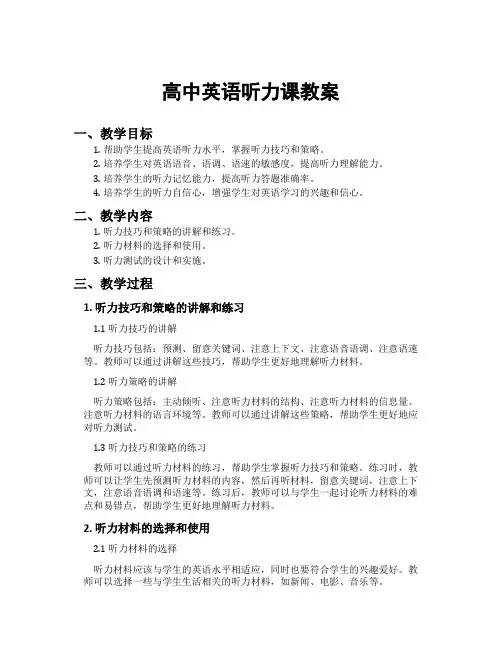
高中英语听力课教案一、教学目标1.帮助学生提高英语听力水平,掌握听力技巧和策略。
2.培养学生对英语语音、语调、语速的敏感度,提高听力理解能力。
3.培养学生的听力记忆能力,提高听力答题准确率。
4.培养学生的听力自信心,增强学生对英语学习的兴趣和信心。
二、教学内容1.听力技巧和策略的讲解和练习。
2.听力材料的选择和使用。
3.听力测试的设计和实施。
三、教学过程1. 听力技巧和策略的讲解和练习1.1 听力技巧的讲解听力技巧包括:预测、留意关键词、注意上下文、注意语音语调、注意语速等。
教师可以通过讲解这些技巧,帮助学生更好地理解听力材料。
1.2 听力策略的讲解听力策略包括:主动倾听、注意听力材料的结构、注意听力材料的信息量、注意听力材料的语言环境等。
教师可以通过讲解这些策略,帮助学生更好地应对听力测试。
1.3 听力技巧和策略的练习教师可以通过听力材料的练习,帮助学生掌握听力技巧和策略。
练习时,教师可以让学生先预测听力材料的内容,然后再听材料,留意关键词,注意上下文,注意语音语调和语速等。
练习后,教师可以与学生一起讨论听力材料的难点和易错点,帮助学生更好地理解听力材料。
2. 听力材料的选择和使用2.1 听力材料的选择听力材料应该与学生的英语水平相适应,同时也要符合学生的兴趣爱好。
教师可以选择一些与学生生活相关的听力材料,如新闻、电影、音乐等。
2.2 听力材料的使用教师可以通过多种方式使用听力材料,如听力练习、听力测试、听力讲解等。
在使用听力材料时,教师应该注意材料的难易程度和学生的接受能力,避免过于简单或过于难的听力材料。
3. 听力测试的设计和实施3.1 听力测试的设计听力测试应该包括听力理解和听力记忆两个方面。
听力理解测试可以通过选择题、填空题等形式进行,测试学生对听力材料的理解程度。
听力记忆测试可以通过听力复述、听力翻译等形式进行,测试学生对听力材料的记忆能力。
3.2 听力测试的实施听力测试应该在课堂上进行,测试时间应该控制在20分钟以内。
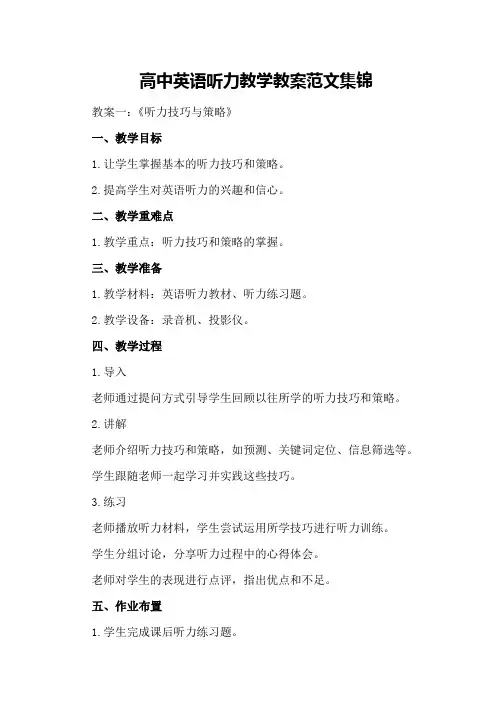
高中英语听力教学教案范文集锦教案一:《听力技巧与策略》一、教学目标1.让学生掌握基本的听力技巧和策略。
2.提高学生对英语听力的兴趣和信心。
二、教学重难点1.教学重点:听力技巧和策略的掌握。
三、教学准备1.教学材料:英语听力教材、听力练习题。
2.教学设备:录音机、投影仪。
四、教学过程1.导入老师通过提问方式引导学生回顾以往所学的听力技巧和策略。
2.讲解老师介绍听力技巧和策略,如预测、关键词定位、信息筛选等。
学生跟随老师一起学习并实践这些技巧。
3.练习老师播放听力材料,学生尝试运用所学技巧进行听力训练。
学生分组讨论,分享听力过程中的心得体会。
老师对学生的表现进行点评,指出优点和不足。
五、作业布置1.学生完成课后听力练习题。
教案二:《听力材料分析与解题技巧》一、教学目标1.让学生了解听力材料的特点和难点。
2.培养学生分析听力材料的能力。
3.提高学生解题技巧。
二、教学重难点1.教学重点:听力材料的特点和难点分析。
2.教学难点:解题技巧的培养。
三、教学准备1.教学材料:英语听力教材、听力练习题。
2.教学设备:录音机、投影仪。
四、教学过程1.导入老师通过提问方式引导学生回顾以往所学的听力材料特点。
2.讲解老师分析听力材料的特点和难点,如语速、语音、背景知识等。
学生跟随老师一起学习并实践分析听力材料的方法。
3.练习老师播放听力材料,学生尝试分析并解题。
学生分组讨论,分享解题过程中的心得体会。
老师对学生的表现进行点评,指出优点和不足。
五、作业布置1.学生完成课后听力练习题。
教案三:《听力实战演练》一、教学目标1.让学生将所学听力技巧和策略应用于实际听力训练中。
2.提高学生的听力水平。
二、教学重难点1.教学重点:听力实战演练。
2.教学难点:学生在实际听力过程中的问题解决。
三、教学准备1.教学材料:英语听力教材、听力练习题。
2.教学设备:录音机、投影仪。
四、教学过程1.导入老师通过提问方式引导学生回顾以往所学的听力技巧和策略。
一、教学目标1. 知识目标:掌握听力材料的结构和常见题型,提高听力理解能力。
2. 能力目标:培养学生在实际情境中运用听力材料的能力,提高听力技巧。
3. 情感目标:激发学生对英语听力的兴趣,培养良好的学习习惯。
二、教学重点1. 听力材料的结构和常见题型;2. 听力技巧的培养;3. 实际情境中的听力运用。
三、教学难点1. 听力材料的理解;2. 听力技巧的掌握;3. 实际情境中的听力运用。
四、教学过程1. 导入(1)播放一段与课程相关的英语歌曲或视频,激发学生的兴趣;(2)简单介绍本节课的教学目标和内容。
2. 预习(1)学生根据教材,预习听力材料;(2)教师检查预习情况,解答学生在预习过程中遇到的问题。
3. 听力训练(1)播放听力材料,学生边听边完成听力任务;(2)教师讲解听力材料,分析题目,讲解答案;(3)学生复述听力材料,加深对材料的理解。
4. 听力技巧讲解(1)讲解听力材料的常见题型,如选择题、填空题、判断题等;(2)讲解听力技巧,如预测、略读、精听等;(3)通过实际例子,让学生掌握听力技巧。
5. 实际情境听力运用(1)设计实际情境,让学生运用所学听力技巧进行听力练习;(2)教师点评学生的表现,指出不足,提出改进建议。
6. 总结与反思(1)总结本节课所学内容,强调听力技巧和实际情境运用;(2)学生分享自己的学习心得,教师点评。
五、教学评价1. 学生对听力材料的理解程度;2. 学生运用听力技巧的能力;3. 学生在实际情境中的听力运用能力。
六、教学延伸1. 鼓励学生课后多听英语材料,提高听力水平;2. 组织英语角活动,让学生在实际情境中运用听力技巧;3. 定期进行听力测试,检查学生的学习成果。
通过以上教学过程,相信学生能够在高中英语听力教学中取得良好的效果,为今后的英语学习打下坚实的基础。
课时:1课时教学目标:1. 培养学生良好的听力习惯,提高听力理解能力。
2. 帮助学生掌握听力技巧,提高听力考试得分。
3. 增强学生的英语口语表达能力,提高实际运用英语的能力。
教学重点:1. 听力技巧的掌握。
2. 词汇和句型的积累。
3. 听力材料的理解。
教学难点:1. 学生对听力材料的理解。
2. 学生听力技巧的运用。
教学准备:1. 听力材料:课文、听力练习、听力测试等。
2. 多媒体设备:电脑、投影仪等。
3. 听力训练软件。
教学过程:一、导入1. 教师简要介绍本节课的学习目标和内容。
2. 通过提问,引导学生回顾上节课的学习内容,激发学生的学习兴趣。
二、新课导入1. 教师播放一段听力材料,让学生初步感知听力内容。
2. 学生听后,教师提问:What did you hear? 引导学生回答,检查学生的听力理解情况。
三、听力技巧讲解1. 教师讲解听力技巧,如:预读、听关键词、听主旨大意、听细节等。
2. 通过实例分析,让学生了解这些技巧在实际听力中的应用。
四、听力练习1. 教师分发听力练习材料,让学生进行自主练习。
2. 学生完成练习后,教师组织学生进行小组讨论,交流听力心得。
五、听力测试1. 教师播放听力测试材料,学生进行听力测试。
2. 学生完成测试后,教师组织学生进行答案讲解,检查学生的听力理解情况。
六、课堂小结1. 教师总结本节课的学习内容,强调听力技巧的重要性。
2. 学生分享自己在听力练习中的收获和体会。
七、布置作业1. 学生完成课后听力练习,巩固所学知识。
2. 学生根据所学技巧,进行自主听力训练。
教学反思:1. 本节课是否达到了预期的教学目标?2. 学生在听力练习中的表现如何?3. 教学过程中,是否存在不足之处?4. 如何改进教学方法,提高学生的听力水平?板书设计:一、导入1. 学习目标2. 内容回顾二、新课导入1. 听力材料感知三、听力技巧讲解1. 预读2. 听关键词3. 听主旨大意4. 听细节四、听力练习1. 自主练习2. 小组讨论五、听力测试1. 听力测试2. 答案讲解六、课堂小结1. 学习内容总结2. 体会分享七、布置作业1. 课后练习2. 自主训练。
高中听力训练教案六听力训练在高中英语教学中具有重要的地位,对学生英语听力、口语能力的提升至关重要。
本篇文章将介绍一份高中听力训练教案,以帮助教师有效组织和进行听力训练。
I. 教学目标本次听力训练的目标主要包括:1. 提高学生的听力技巧和听力表达能力;2. 培养学生对不同题型的理解和应对能力;3. 培养学生的听力策略和思维能力。
II. 教学准备1. 选取合适的听力材料,确保听力内容与学生水平相适应;2. 准备录音设备和播放设备;3. 将听力材料的录音文字版整理好。
III. 教学过程1. Pre-listening在开始听力训练之前,教师可以通过引导学生回顾相关词汇和语法知识,创设相关场景,激发学生兴趣,为听力训练做好铺垫。
2. While-listening(1)Task 1: Short dialogue comprehension播放一段短对话,要求学生根据问题选择正确答案。
教师可以提前准备好几个相关问题,确保问题涵盖所学的重点内容,并根据学生的实际水平适当调整难度。
(2)Task 2: Note-taking播放一段较长的听力材料,如一节课堂讲座、一段新闻报道等,要求学生做笔记。
提前告诉学生听力材料的大致内容,帮助他们更好地理解和捕捉关键信息。
(3)Task 3: Dialogue completion播放一段对话,留白处需要学生根据上下文填写恰当的答案或信息。
这一任务旨在培养学生捕捉关键信息的能力,同时加强对上下文理解的能力。
3. Post-listening(1)Task 1: Discussion指导学生进行小组或全班讨论,分享他们对听力材料的理解和观点,并提出相关问题。
通过相关问题的讨论,加深学生对听力材料的理解和思考,拓宽他们的思维广度。
(2)Task 2: Retelling要求学生以口头形式或书面形式完成对听力材料的复述。
这一任务可以帮助学生巩固所听到的信息,提升他们的听力表达能力。
教学目标:1. 培养学生对英语听力的兴趣,提高听力理解能力。
2. 帮助学生掌握听力技巧,提高听力成绩。
3. 培养学生的英语语感和语调感知能力。
教学重点:1. 听力技巧的掌握。
2. 词汇和语法知识的运用。
3. 英语语感和语调感知能力的培养。
教学难点:1. 学生在听力过程中对词汇和语法知识的理解。
2. 学生在听力过程中对语调和语感的把握。
教学过程:一、导入1. 教师播放一段英语听力材料,让学生初步感知英语听力。
2. 引导学生谈谈自己对英语听力的认识和感受。
二、听力技巧讲解1. 教师讲解听力技巧,如:预测、猜测、抓关键词等。
2. 让学生结合实例,练习运用这些技巧。
三、词汇和语法知识讲解1. 教师针对听力材料中的词汇和语法知识进行讲解,帮助学生理解和运用。
2. 学生练习相关词汇和语法知识,巩固所学内容。
四、听力练习1. 教师播放听力材料,让学生进行听力练习。
2. 学生边听边记录关键信息,并尝试回答问题。
3. 教师播放听力材料,让学生再次听并回答问题,纠正错误。
五、总结与反思1. 教师总结本次课的重点和难点,帮助学生梳理知识。
2. 学生谈谈自己在听力过程中的收获和不足,提出改进措施。
教学评价:1. 通过课堂提问、小组讨论等方式,评价学生对听力技巧的掌握程度。
2. 通过学生回答问题的情况,评价学生对词汇和语法知识的理解程度。
3. 通过学生听力的实际表现,评价学生的英语语感和语调感知能力。
教学反思:1. 教师根据学生的学习情况,调整教学方法和内容。
2. 教师关注学生的个体差异,因材施教。
3. 教师不断提高自己的专业素养,为学生提供更好的教学服务。
课时:2课时教学目标:1. 学生能够掌握英语听力训练的基本技巧。
2. 学生能够提高听力理解能力,提高英语听力的准确性和速度。
3. 学生能够在实际情境中运用所学的听力技巧。
教学重点:1. 听力训练的方法和技巧。
2. 提高听力理解能力的策略。
教学难点:1. 如何在实际情境中运用听力技巧。
2. 如何提高学生的自信心和耐心。
教学准备:1. 英语听力材料(包括对话、短文、讲座等)。
2. 教学课件。
3. 录音设备。
教学过程:第一课时一、导入1. 通过播放一段英语听力材料,让学生感受英语听力的难度和挑战。
2. 引导学生思考:如何提高英语听力?二、听力训练技巧讲解1. 介绍听力训练的基本方法,如:- 浏览题干和选项,确定材料话题。
- 根据关键词锁定材料信息。
- 重点关注材料的首句和尾句。
- 从记忆中重拾材料原文,根据前后题干有联系的选择选项。
2. 讲解听力技巧,如:- 识别音素,提高对语音的敏感度。
- 了解连读规律,提高对快速语音的识别能力。
- 练习听力速度,逐步提高听力速度。
三、听力练习1. 分组练习,每组选取一篇听力材料进行练习。
2. 教师巡视指导,解答学生疑问。
四、总结与反馈1. 学生分享练习心得,教师进行点评和总结。
2. 强调听力训练的重要性,鼓励学生坚持练习。
第二课时一、复习上节课所学的听力技巧1. 通过提问的方式,让学生回顾上节课所学的听力技巧。
2. 学生分组讨论,分享自己的听力技巧。
二、实际情境中的听力技巧运用1. 播放一段英语听力材料,让学生尝试运用所学的听力技巧。
2. 教师巡视指导,解答学生疑问。
三、小组合作听力练习1. 将学生分成若干小组,每组选取一篇听力材料进行合作练习。
2. 小组成员分工合作,共同完成听力任务。
四、总结与反馈1. 学生分享练习心得,教师进行点评和总结。
2. 鼓励学生在日常生活中多听、多说,提高英语听力水平。
教学评价:1. 通过学生的课堂表现和练习情况,评价学生对听力技巧的掌握程度。
教学目标:1. 帮助学生掌握英语听力技巧,提高听力水平。
2. 培养学生良好的听力习惯,提高听力理解能力。
3. 激发学生对英语听力的兴趣,增强学习动力。
教学重点:1. 英语听力技巧的掌握。
2. 听力理解能力的提高。
教学难点:1. 学生在听力过程中遇到的难点问题。
2. 如何帮助学生克服这些难点。
教学准备:1. 教学课件。
2. 英语听力材料。
3. 听力练习题。
教学过程:一、导入1. 教师简要介绍英语听力的重要性。
2. 引导学生谈谈自己在英语听力方面遇到的困难。
二、讲解听力技巧1. 预测技巧:在听录音前,根据上下文和问题预测可能的内容。
2. 速记技巧:在听录音过程中,快速记录关键词和关键信息。
3. 细节理解技巧:在听录音过程中,关注细节,理解文章主旨和要点。
4. 推理判断技巧:根据已知信息,进行合理推理和判断。
三、实践练习1. 教师播放英语听力材料,让学生进行听力练习。
2. 学生在听录音过程中,运用所学技巧,完成练习题。
四、讲解练习题答案1. 教师针对练习题,讲解正确答案和解题思路。
2. 学生总结自己在听力过程中遇到的问题,并请教教师。
五、总结与反思1. 教师总结本节课所学的英语听力技巧。
2. 学生反思自己在英语听力方面的进步和不足。
教学评价:1. 通过课堂练习和课后作业,了解学生对英语听力技巧的掌握程度。
2. 通过学生的听力成绩,评价教学效果。
教学反思:1. 课堂氛围是否活跃,学生参与度如何。
2. 教学内容是否符合学生的实际需求。
3. 教学方法是否有效,是否需要调整。
课后作业:1. 完成课后听力练习题。
2. 观看英语听力材料,提高自己的听力水平。
备注:1. 教师可根据学生的实际情况,调整教学内容和进度。
2. 鼓励学生在课后多听英语材料,提高自己的听力能力。
高中英语听力教案
教案标题:提高高中英语听力能力
一、教学目标:
1. 培养高中学生的英语听力技能,包括听力识别和理解能力的提升。
2. 提高学生的听力推测和推断能力,培养他们的综合阅读能力。
3. 培养学生的听取关键信息和笔记技巧,以提高他们在听力考试中
的成绩。
二、教学重难点:
1. 学生对于英语听力的记忆和理解能力不足,提高学生的听力技能。
2. 学生对于英语听力中的隐含信息和上下文信息的掌握不够,培养
学生的推测和推断能力。
三、教学准备:
1. 多媒体设备或录音机。
2. 教学课件和听力材料。
3. 学生习题和笔记本。
四、教学过程:
1. 导入(5分钟):
利用一段短视频或图片引发学生对主题的兴趣和讨论,引入今天的听力主题。
2. 听力活动(30分钟):
a. 给学生播放一段旨在测试他们听力水平的短对话或文章,让学生尽力听懂并记录重要信息。
b. 给学生一些与听力材料相关的问题,以帮助他们更好地理解听力内容。
c. 分组讨论:学生将根据听到的内容,交流并推测可能的听力材料主题和情景。
d. 听力复述:请学生用他们自己的话复述所听到的内容,以帮助他们巩固所学知识。
3. 听力技巧讲解(10分钟):
a. 介绍一些听音技巧,如听关键词、听语境、推测未知词义等,帮助学生提高听力能力。
b. 提供一些练习例子,并与学生一起分析解答过程。
4. 提高听力的练习(15分钟):
a. 给学生分发一些练习题,要求他们根据听力材料回答问题。
b. 学生进行练习,并及时回答问题。
5. 反馈和评价(5分钟):
a. 完成练习后,教师将与学生一起检查答案,检查学生的听力理解水平。
b. 教师提供针对学生听力策略和技巧的反馈和建议。
六、巩固与拓展:
1. 布置听力作业:要求学生自主选择一篇英语文章进行听力,记录重要信息,并用他们自己的话复述文章内容。
2. 鼓励学生参加英语角活动或其他英语听力训练机会,以加强他们的听力技能。
3. 提供一些额外的听力材料和习题,供学生自主学习和练习。
通过以上教案的指导和实施,学生的英语听力能力将得到提高,他们将更加自信地面对听力考试并取得好成绩。